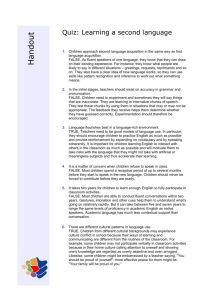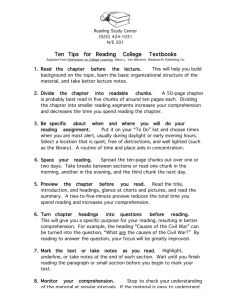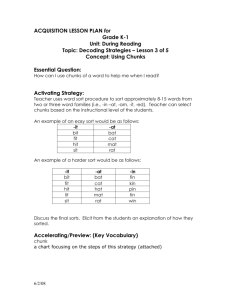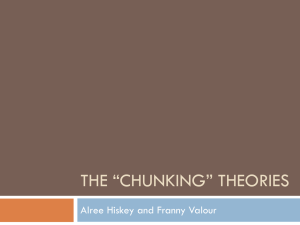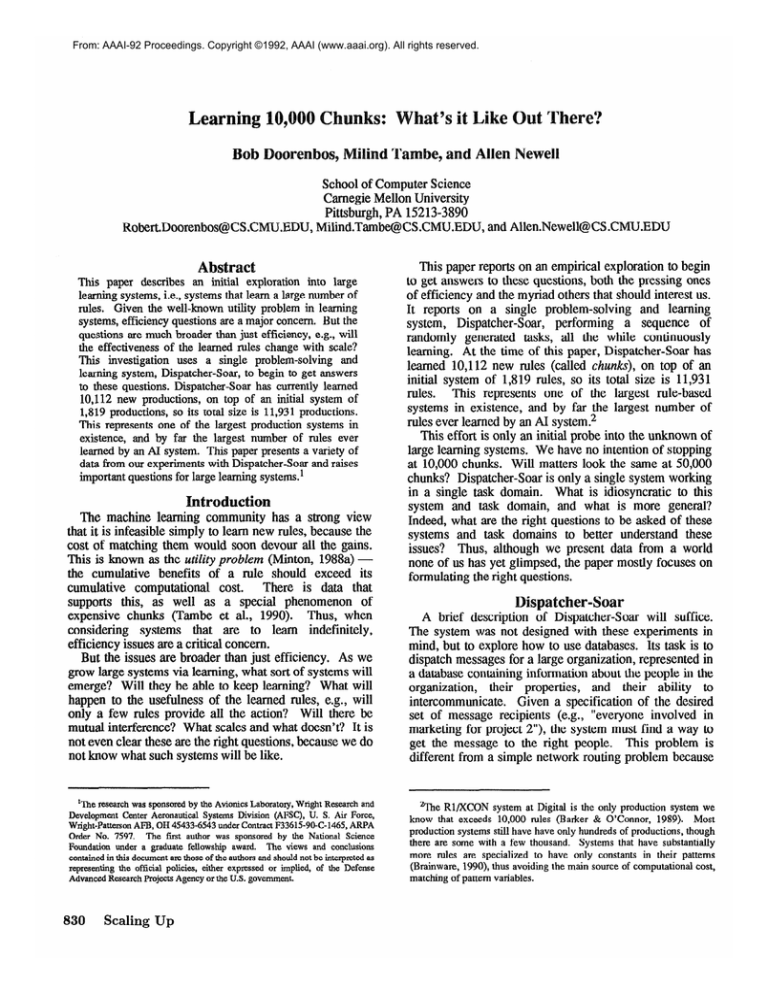
From: AAAI-92 Proceedings. Copyright ©1992, AAAI (www.aaai.org). All rights reserved.
Robert.Doorenbos@CS.CMU.EDU,
School of Computer Science
Carnegie Mellon University
Pittsburgh, PA 15213-3890
Milind.Tambe@CS.CMU.EDU, and Allen.Newell@CS.CMU.EDU
Abstract
This paper describes an initial exploration into large
learning systems, i.e., systems that learn a large number of
rules. Given the well-known utility problem in learning
systems, efficiency questions are a major concern. But the
questions are much broader than just efficiency, e.g., will
the effectiveness of the learned rules change with scale?
This investigation
uses a single problem-solving
and
learning system, Dispatcher-Soar,
to begin to get answers
to these questions. Dispatcher-Soar
has currently learned
10,112 new productions, on top of an initial system of
1,819 productions, so its total size is 11,931 productions.
This represents one of the largest production systems in
existence, and by far the largest number of rules ever
learned by an AI system. This paper presents a variety of
data from our experiments with Dispatcher-Soar and raises
important questions for large learning systems1
Introduction
The machine learning community has a strong view
that it is infeasible simply to learn new rules, because the
cost of matching them would soon devour all the gains.
This is known as the utility problem (Minton, 1988a) the cumulative benefits of a rule should exceed its
There is data that
cumulative computational cost.
supports this, as well as a special phenomenon of
expensive chunks (Tambe et al., 1990). Thus, when
considering systems that are to learn indefinitely,
efficiency issues are a critical concern.
But the issues are broader than just efficiency. As we
grow large systems via learning, what sort of systems will
emerge? Will they be able to keep learning? What will
happen to the usefulness of the learned rules, e.g., will
only a few rules provide all the action? Will there be
mutual interference? What scales and what doesn’t? It is
not even clear these are the right questions, because we do
not know what such systems will be like.
‘The research was sponsored by the Avionics Laboratory, Wright Research and
Development Center Aeronautical Systems Division (AFSC), U. S. Air Force,
Wright-Patterson AFB, OH 45433-6543 under Contract F33615-9&C-1465, ARPA
Order No. 7597.
The first author was sponsored by the National Science
Foundation under a graduate fellowship award.
The views and conclusions
contained in this document am those of the authors and should not be interpreted as
representing the official policies, either expressed or implied, of the Defense
Advanced Research Projects Agency or the U.S. government.
830
Scaling
Up
This paper reports on an empirical exploration to begin
to get answers to these questions, both the pressing ones
of efficiency and the myriad others that should interest us.
It reports on a single problem-solving and learning
system, Dispatcher-Soar, performing a sequence of
randomly generated tasks, all the while continuously
learning. At the time of this paper, Dispatcher-Soar has
learned 10,112 new rules (called chunks), on top of an
initial system of 1,819 rules, so its total size is 11,93 1
rules. This represents one of the largest rule-based
systems in existence, and by far the largest number of
rules ever learned by an AI system.2
This effort is only an initial probe into the unknown of
large learning systems. We have no intention of stopping
at 10,000 chunks. Will matters look the same at 50,000
chunks? Dispatcher-Soar is only a single system working
in a single task domain. What is idiosyncratic to this
system and task domain, and what is more general?
Indeed, what are the right questions to be asked of these
systems and task domains to better understand these
issues? Thus, although we present data from a world
none of us has yet glimpsed, the paper mostly focuses on
formulating the right questions.
ispatcher-Soar
A brief description of Dispatcher-Soar will suffice.
The system was not designed with these experiments in
mind, but to explore how to use databases. Its task is to
dispatch messages for a large organization, represented in
a database containing information about the people in the
organization, their properties, and their ability to
intercommunicate. Given a specification of the desired
set of message recipients (e.g., “everyone involved in
marketing for project 2’7, the system must find a way to
get the message to the right people. This problem is
different from a simple network routing problem because
?-The Rl/XCON system at Digital is the only production system we
know that exceeds 10,000 rules (Barker & O’Connor, 1989). Most
production systems still have have only hundreds of productions, though
there are some with a few thousand.
Systems that have substantially
more rules are specialized to have only constants in their patterns
(Brainware, 1990), thus avoiding the main source of computational cost,
matching of pattern variables.
both communication links and desired recipients are
specified in terms of properties of people - for example,
a communication link might be specified by “John can
talk to all the marketing people at headquarters.” Also,
the data is available only indirectly in a database, which is
external to Dispatcher-Soar, rather than part of it.
Whenever Dispatcher-Soar needs some piece of
information from the database, it must formulate a query
using the SQL database-query language, send the query
off to a database system, and interpret the databasesystem’s response.
Dispatcher-Soar is implemented using Soar, an
integrated problem-solving and learning system, already
well-reported in the literature (Laird, Newell, &
Rosenbloom, 1987; Rosenbloom et al., 1991). Soar is
based on formulating every task as search in problem
spaces. Each step in this search the selection of
problem spaces, states and operators, plus the immediate
application of operators to states to generate new states is a decision cycle. The knowledge necessary to execute a
decision cycle is obtained from Soar’s knowledge base,
implemented as a production system (a form of rule-based
system). If this knowledge is insufficient to reach a
decision, Soar makes use of recursive problem-space
search in subgoals to obtain more knowledge. Soar learns
by converting this subgoal-based search into chunks,
productions that immediately produce comparable results
under analogous conditions (Laud, Rosenbloom, &
Newell, 1986). Chunking is a form of explanation-based
learning (EBL) (DeJong $ Mooney, 1986; Mitchell,
Keller, & Kedar-Cabelli, 1986; Rosenbloom & Laird,
1986).
Dispatcher-Soar is implemented using 20 problem
spaces. Figure 1 shows these problem spaces as triangles,
arranged in a tree to reflect the structure of the system:
one problem space is another’s child if the child space is
used to solve a subgoal of the parent space. (The boxed
numbers will be explained later.) The 8 problem spaces
in the upper part of the figure are involved with the
dispatching task: three basic methods of performing the
task, together with a method for selecting between them.
The 12 lower problem spaces are involved with using the
external database.
43-i
et
Dispatcher-Soar begins with 1,819 initial (unlearned)
productions, and uses a database describing an
organization of 61 people.
The details of this
organization were created by a random generator,
weighted to make the organization modestly realistic, e.g.,
people in the same region are more likely to have a
communication link between them than people in
different regions.
We generated 200 different base problems for
Dispatcher-Soar, using a random problem generator with
weighted probabilities. (A problem is just an instance of
the dispatching task, e.g., “Send this message to everyone
involved in marketing for project 2.“) We then had
Dispatcher-Soar solve each base problem in turn, learning
as it went along.
Starting from the initial 1,819production system, Dispatcher-Soar required 3,143
decision cycles to solve the first problem, and built 556
chunks in the process. Then, starting with the initial
productions plus the chunks from the first problem, the
system solved the second problem. It continued in this
fashion, eventually solving problem 200 using the initial
productions together with all the chunks it had learned on
the first 199 problems.
After solving 200 base problems, the system had
learned a total of 10,112 chunks (an average of 506 per
problem space), bringing the total number of productions
to 11,931. Figure 1, (1) in the box, gives the number of
these chunks in each problem space and Figure 1 (2) gives
their distribution over the spaces?Approximately 30% of
the chunks are search-control rules (the selection space),
used to choose between the different methods the system
has available to it. Another 32% of the chunks help
implement various operators (many spaces).
The
remaining 38% contain memorized database query results
(the memory and database-query spaces), and are based
on the memorization
technique
introduced
in
(Rosenbloom & Aasman, 1990). Whenever DispatcherSoar has to go out to the database to find some piece of
information, it memorizes it; if the information is needed
again, the database will not have to be consulted. These
chunks transfer to other problems - Dispatcher-Soar
solved 42 of the 200 base problems without consulting the
database.
However, it did not memorize the entire
database - it still had to consult it during problem 200.
e
Figure 2 plots the rate at which chunks are built. The
horizontal axis in the figure gives both cumulative
decision cycles and cumulative production firings. (We
will show later that these two numbers are proportional.)
The vertical axis gives the number of chunks built. The
figure shows that the rate of chunking remains remarkably
constant over time - on average, one chunk is built every
6.3 decision cycles. The rate of chunking was indeed
expected to stay roughly the same throughout the run
(Newell, 1990). However, the constant rate is intriguing
because it holds up over a long period of time, despite the
different problem spaces employed and the variety of
chunks learned (see Figure 1). Even more intriguing, the
RW,
3The results reported here are for Dispatcher-Soar
and Soar
version 5.2.2 using all-goals chunking.
Times are user cpu time on a
DECstation 5000, excluding Lisp garbage collection time. In addition to
the chunks reported here, Soar also builds internal chunks, which have
only constants (no variables) in their conditions and are excised
following the completion of each problem. Internal chunks appear to
affect our results only slightly and are ignored here. Two problem
spaces build no chunks. The top space cannot build chunks because it
has no parent. The send-query-and-get-response
(SQAGR) space builds
only internal chunks. An additional problem space is used to wait for
results to be returned from the external database.
It does no problem
solving and is omitted here.
oorenbos,
Tarnbe,
and Newell
831
Figure 1: Dispatcher-Soar
problem spaces and associated chunks.
same rate of approximately 1 chunk per 6 decision cycles
was observed on a smaller scale (-100 chunks) in a
completely different set of tasks (Tambe et al., 1990,
Tambe, 199 1).
A second interesting phenomenon is that in some of the
problem spaces, the rate of chunking is highly nonuniform. Figure 1 (3) shows the percent of chunks that
were built during the first half of the run, i.e., the first
50% of the total decision cycles required to solve the 200
problems. For example, the figure indicates that 87% of
the chunks from the pathfinder space were built during
the first half of the run. So the rate at which pathjkder
chunks are built drops significantly over the course of the
run. For the find-all-matches space, on the other hand,
only 34% of the chunks were built during the first half of
the run, so the chunking rate for this space is increasing
over the course of the run.
832
Scaling
Up
00-v
0
I
0
I
10000
30000
50000
D = cumulative decision cycles
200
400
600
800
1000 1200
Cumulative production firings (thousands)
Figure 2: Chunks built on 200 base problems:
4
70000
I
1400
C=D/6.3.
As more and more chunks are built in a problem space,
the space may become inactive: the space is never used
again, because in every situation where it would
previously have been used, some chunk fires to handle the
In Dispatcher-Soar, some spaces
situation instead.
become inactive very quickly: the table-list-text space
was used during the first problem, built one chunk, and
was never needed again - from then on, that single
chunk transferred to all the situations where it was
needed. Other spaces take longer to become inactive: the
where-conditions-list-text space became inactive during
problem 19, and the pat?finder space became inactive
during problem 164. Many spaces show no sign of
becoming inactive, even after 200 problems.
As mentioned above, Figure 2 has horizontal scales for
both cumulative decision cycles and cumulative
production firings. In this paper we work primarily in
terms of decision cycles, the natural unit of cognitive
action in Soar. However, production firings are another
familiar base unit. While the number of production
firings that make up a decision cycle varies from one
decision cycle to the next, Figure 3 shows that the number
of cumulative production firings is proportional to the
number of cumulative decision cycles, with a conversion
factor of approximately 20.5 production firings per
decision cycle. Figures 2 and 3 together show that chunks
built, cumulative decision cycles, and cumulative
production firings are all proportional to one another: 6.3
decision cycles per chunk and 20.5 production firings per
decision cycle (hence, 130 production firings per chunk).
Our graphs will have extra scales, based on these
conversion factors.
is bolstered by static measurements of the Rete algorithm
(Forgy, 1982) employed in Soar for production match:
with the addition of 10,000 chunks, the Rete network size
(interpreted code size) increases eight-fold.
The mystery that emerges from Dispatcher-Soar is the
absence of any average growth effect! Figure 4 illustrates
this. It plots the number of cumulative decision cycles
over the 200 base problems on the horizontal axis, and the
number of token changes per decision cycle on the
vertical axis. A token is a partial instantiation of a
production, indicating what conditions have matched with
what variable bindings. The number of tokens generated
by the matcher during a decision cycle is a commonly
used implementation-independent measure of the amount
of match effort in that decision cycle (Gupta, 1986;
Minton, 1988b; Nayak, Gupta, & Rosenbloom, 1988;
Tambe et al., 1990). In Figure 4, each point indicates the
number of token changes per decision cycle during a lodecision cycle interval. The figure shows that over the
course of about 65,000 decision cycles and the addition of
10,112 chunks, there is no increase in token changes per
decision cycle. In fact, a least-squares fit indicates a
slightly decreasing trend.
Q,
z
$8
s8
dv
e
0
Number of chunks built
4000
6000
8000
2000
10000
- . :
0
r
0
10000
30000
50000
Cumulative decision cycles
200
400
600
800
1000
1200
Cumulative production firings (thousands)
70000
8
1400
Figure 4: Token changes per decision cycle.
9
zzE
Jo
II 0
I
1
10000
a
t
30000
50000
D = cumulative decision cycles
70000
Figure 3: Production firings vs. decision cycles: P=20.5 xD.
The
Cost
of
10,
Data from existing EBL systems (Etzioni, 1990;
Minton, 1988a; Cohen, 1990), including some small Soar
systems (Tambe et al., 1990), predicts that a large number
of chunks will extract a heavy match cost. This increase
in match cost due to the accumulation of a large number
of chunks is referred to as the average growth effect
(AGE).4 The prediction of a high AGE in Dispatcher-Soar
4While (Tambe et al., 1990) reported on the AGE phenomenon, their
main focus was on enpensive chunks, i.e., individual chunks that
consume a large amount of match effort. Our focus is on the impact of
large numbers of individually inexpensive chunks.
A variety of hypotheses have so far failed to explain
this lack of average growth effect. One hypothesis was
that the chunks were simply sharing existing parts of the
Rete network, thus not adding to the match activity
(Tambe et al., 1990). But this is not the case, as the
network size turns out to grow in rough proportion to the
number of productions in the system. Another hypothesis
was that a finer-grained analysis at a level below the
decision cycles would reveal the missing average growth
effect. Figure 5 presents such a finer-grained analysis: it
plots the number of token changes per change to working
memory during the 200 base problems5 But it shows no
AGE either. Yet another hypothesis was that the chunks
do not incur match cost, because they don’t match
‘As noted earlier, each decision cycle involves about 20 production
firings. Each of these involves executing right-hand-side action to add
or delete working-memory
elements.
Doorenbos,
Tambe,
and Newell
833
variables or because they never match. But the chunks
test many variables in their conditions, not just constants.
And they often match, as the next section indicates.
0
2000
s
Number of chunks built
4000
6000
8000
3
-a
8;.
2
Y
.
.I
I
I
0
10000
I
0
30000
50000
Cumulative decision cycles
200
400
600
800
1000
1200
Cumulative production firings (thousands)
30000
50000
Cumulative decision cycles
200
400
600
800
1000
1200
Cumulative production firings (thousands)
-I
10000
:
I
I
0
I
0
10000
10000
.
.l-E
--I-
Number of chunks built
4000
6000
8000
2000
0
70000
70000
7
1400
Figure 6: Time per decision cycle.
I
1400
Figure 5: Token changes per action.
Interestingly, the absence of AGE is consonant with the
expectations of a different section of the AI community.
One of the key experimental results in the area ofparallel
production system is that the match activity in a
production system does not increase with the number of
productions (Gupta, 1986; Miranker, 1987; Oflazer,
1987). However, this experimental result is based on
non-learning OPS5 production systems (Brownston et al.,
1985) with substantially smaller numbers of productions
than Dispatcher-Soar (-100 to -1000 productions). The
relation between the results in this paper and those in
(Gupta, 1986; Miranker, 1987; Qflazer, 1987) remains
unclear.
A second unexpected phenomenon in Dispatcher-Soar
is that, in spite of the lack of increase in token changes,
the total execution time per decision cycle shows a
gradual increase as chunks are added to the system.
Figure 6 plots this time per decision cycle over the course
of the 200 base problems. Again, each point indicates the
time per decision cycle during a lo-decision cycle
interval. A linear fit indicates that the time per decision
cycle is initially 1.28 seconds, and increases by 0.47
seconds per 10,000 chunks. This is certainly a growth
effect, but its source is unclear. The total execution time
includes the time spent in matching, chunk building,
tracing and other activities of the Soar system. A new,
highly instrumented version of Soar is currently under
development (Milnes et al., 1992), which should allow us
to understand this phenomenon.
The Effectiveness of Learning
To explore the effectiveness of Dispatcher-Soar’s
learning, Figure 7 plots the number of decision cycles for
each of the 200 base problems in sequence.
The
horizontal axis plots the problem number and the vertical
axis plots the problem duration in decision cycles. The
figure shows more long problems at the beginning than at
the end and that almost all the later problems are short.
As Dispatcher-Soar continuously accumulates chunks, it
is able to solve problems faster, i.e., in fewer decision
cycles, which is direct evidence for effective learning.
834
Scaling
Up
0
50
100
150
Base problem number
200
Figure 7: Durations of the base problems.
For a continuously learning system, we can ask
whether all the useful learning occurs early on, or whether
later learning is still effective. Are the rules learned
during the second 10 problems as effective as those
learned during the first 10 problems? Unfortunately, a
fine-grained analysis of Figure 7 is useless because of the
variance in the problem durations. (This has two causes:
varying difficulty of the base problems and varying
amounts of chunk transfer.) We could smooth out the
variance by taking an average every 50 problems -if the
average problem-solving time of the last 50 problems
were less than that of the previous 50, we could conclude
that the learning in later problems is useful.
But
averaging prevents getting fine-grained information on
the effectiveness of learning. Averaging 50 problems, we
will not get information about the effectiveness of the
learning from the first 10 problems as compared to the
second 10 problems.
Instead of averaging, we used a set of probe problems.
We selected 10 probe problems, generated by the same
random generator as the base problems, but disjoint from
the base problems. 6 To ensure that this small set
6All the problems must be different. If Soar were presented with the
same problem twice, the second attempt would take just 4 decision
cycles by firing a top-level chunk.
adequately covered the space of problems, we selected
problems of varying difficulty: 3 easy, 3 medium, and 4
hard. The difficulty of a problem was judged by giving it
to the initial Dispatcher-Soar system (no chunks) and
seeing how many decision cycles the system needed to
solve it.
The system’s performance was then tested on each
probe problem, starting with the initial productions plus
the chunks from a varying number of base problems. In
trial 1, we ran each probe problem starting with just the
initial 1,819-production system.7 In trial 2, we ran each
probe problem starting with the initial productions plus
the chunks from base problem 1. And so on, at selected
intervals, up to the last trial, in which we ran each probe
problem starting with the initial productions plus all the
chunks from the 200 base problems.
Figure 8 shows how long the system took to solve the
probe problems, plotted against the trial number. The
three lines (top to bottom) represent the average number
of decision cycles needed for the hard, medium, and easy
probe problems. The number of decision cycles goes
down sharply at first. Hence, the chunks learned in the
early base problems are very useful. The decision cycles
keep decreasing, but less sharply, throughout the trials.
Hence, chunks learned in the later base problems are still
useful, but not as useful as the ones from earlier base
problems.
2
0
50
Q:
Figure 8: Probe-problem
100
Trial number
150
200
durations, grouped by difficulty.
Figure 9 shows the average number of decision cycles
the system needed to solve a probe problem (of any
difficulty) plotted against the trial number on a log-log
The points fall roughly in a straight line:
scale.
Dispatcher-Soar’s learning follows a power law. This
power Eaw of practice shows up throughout human skill
acquisition, and has been previously observed in Soar
(Newell, 1990). That the probe-problem durations follow
such a simple rule is remarkable in itself, and strengthens
‘The system w as allowed to learn as it solved a probe problem.
However, it was started fresh for each of the 10 probes - none of the
other probes’ chunks were used. The durations given here exclude a
handful of decision cycles spent waiting for the database to respond to
queries.
our conviction that the use of probe problems is a crucial
technique for the analysis of continuously learning
systems.
I
5
Figure 9: Probe-problem
I
10
N = trial number
8
50
100
durations, log-log: T=1683~?@.~~~.
Taking the ratio of the probe-problem durations in the
last and first trials, we see that the overall speedup of the
probe problems due to the learning on the 200 base
problems was a factor of 7. This gives us an analogue to
the one-shot learning analysis done in many studies of
learning systems (including Soar) (Minton, 1988a;
Rosenbloom etal., 1985), in which the performance of a
system is compared before and after learning; i.e., a set of
problems is run before any learning takes place; then
learning occurs; then the problems are rerun after
learning is finished.
Overall, 10.3% of the chunks built during the base
problems ever transferred to later base problems. This
number seems low at first, but upon further examination it
is quite reasonable. First, chunks built in later problems
have little opportunity to transfer, since few other
problems were run while those chunks were in the system.
In fact, the chunks built during problem 200 never get a
chance to transfer. Such chunks are hardly useless with more base problems, the fraction of chunks from the
first 200 problems that transfer would increase. Second,
some chunks in child spaces never get a chance to
transfer, because in all the situations where they would,
some chunk in a parent space transfers first and cuts off
The
the subgoaling before the child space arises.
rrep-for-ent space is a good example. It built 55 chunks,
but none of them ever transferred - for each one, a
corresponding chunk from the build-relational-rep space
always transferred instead.
The effectiveness of learning also varies between
problem spaces. Figure 1 (4) shows, for each problem
space, what percent of the chunks built from that space in
one base problem transferred to some later base problem.
For those chunks that did transfer, Figure 1 (5) indicates
the average number of transfers per chunk. There is wide
variance in the effectiveness of learning by problem space
- the percent of chunks that transfer varies all the way
from 0% to 100%. Learning was most effective in those
spaces where a small number of total chunks were built,
but those chunks transferred often.
Doorenbos,
T’ambe, and Newell
835
Questions
This investigation is an initial exploration into very
large learning systems - systems that acquire a very
large number of rules with diverse functionality. The
single system used so far, Dispatcher-Soar, has learned
over 10,000 rules at the time of this paper. We expect to
grow Dispatcher-Soar much further and to grow
additional systems. As phenomena and data accumulate,
we expect to answer some significant questions about
such systems about what it is like out there.
Discovering the right questions is a major part of the
enterprise. The general ones posed in the introduction
certainly remain relevant. But the results presented here
already permit us to formulate some sharper ones.
1. Why is there no average growth effect? Will that
remain true further out? Can we have learning
systems with 100,000 rules? Does this apply to EBL
systems in general?
2. Why does the learning rate stay constant? Is this an
architectural constant, independent of task and
application system? Will different systems have
different (but constant) rates?
What is the
relationship between the constant total rate and the
strongly varying rates by problem space?
3. Does the power law of practice hold further out?
Does it apply for different tasks and systems? What
is behind it?
4. What is the nature of the rules contributing to early
learning (which is very effective) and of those
contributing to late learning (which is less effective)?
5. What characterizes spaces that become inactive?
How do they affect the mix of rules that are being
learned? Can they become active again?
6. What about the structure of Dispatcher-Soar (and
other systems and tasks) determines its long-term
growth and learning properties?
h
Barker, V., O’Connor,
D.
1989.
Expert systems
for
configuration at Digital: XCON and beyond. Communications of
the ACM, 32(3), 298-318.
Brainware. Spring 1990. The BMT expert system. Pragmatica:
Bulletin of the Inductive Progr amming Special Interest Group
(IPISG).
Brownston, L., Farrell, R., Kant, E. and Martin, N.
1985.
Programming expert systems in OPS5: An introduction to rulebased programming.
Reading, Massachusetts:
AddisonWesley.
Cohen, W. W. 1990. Learning Approximate Control Rules of
High Utility. Proceedings of the Sixth International Conference
on Machine Learning, 268-276 .
DeJong, G. F. and Mooney, R.
1986.
Explanation-based
learning: An alternative view. Machine Learning, I(2), 145-176.
Etzioni, 0. 1990. A structural theory of search control. Ph.D.
diss., School of Computer Science, Carnegie Mellon University.
836
Scaling
Up
Forgy, C. L. 1982. Rete: A fast algorithm for the many
pattern/many
object
pattern
match
problem.
Artificial
Intelligence, 19(l), 17-37.
Gupta, A. 1986. Parallelism in production systems. Ph.D. diss.,
Computer Science Department, Carnegie Mellon University.
Also a book, Morgan Kaufmann, (1987).
Laird, J. E., Newell, A. and Rosenbloom, P. S. 1987. Soar: An
architecture
for general intelligence.
Artificial Intelligence,
33(l), l-64.
Laird, J. E., Rosenbloom, P. S. and Newell, A. 1986. Chunking
in Soar: The anatomy of a general learning mechanism. Machine
Learning, 1( l)q 1 l-46.
Milnes, B.G., Pelton, G., Hucka, M., and the Soar6 Group.
1992. Soar6 specification in 2. Soar project, Carnegie Mellon
University, Unpublished.
Minton, S. 1988. Quantitative results concerning the utility of
explanation-based
learning.
Proceedings
of the National
Conference on Artificial Intelligence, 564-569 .
Minton,
S.
1988. Learning Effective Search Control
Knowledge:
Ph.D. diss.,
An explanation-based approach.
Computer Science Department, Carnegie Mellon University.
Miranker, D. P. 1987. Treat: A better match algorithm for AI
production
systems.
Proceedings
of the S&h National
Conference on Artificial Intelligence, 42-47 .
Mitchell, T. M., Keller, R. M., and Kedar-Cabelli, S. T. 1986.
Explanation-based
generalization:
A unifying view. Machine
Learning, I(l), 47-80.
Nayak, P., Gupta, A. and Rosenbloom, P. 1988. Comparison of
the Rete and Treat production matchers for Soar (A summary).
Proceedings of the Seventh National Conference on Artificial
Intelligence, 693-698 .
Newell, A. 1990. Unified Theories of Cognition. Cambridge,
Massachusetts:
Harvard University Press.
Oflazer, K.
1987. Partitioning in Parallel Processing of
Production
Systems.
Ph.D.
diss.,
Computer
Science
Department, Carnegie Mellon University.
Rosenbloom, P.S. and Aasman J. 1990. Knowledge level and
inductive uses of chunking (EBL). Proceedings of the National
Conference on Artijkial Intelligence, 821-827 .
Rosenbloom, P. S. and Laird, J. E. 1986. Mapping explanationbased generalization
onto Soar.
Proceedings of the Fifth
National Conference on Artificial Intelligence, 561-567 .
Rosenbloom, P. S., Laird, J. E., Newell, A., and McCarl, R.
1991. A preliminary analysis of the Soar architecture as a basis
for general
intelligence.
Artificial
Intelligence,
47( l-3),
289-325.
Rosenbloom, P. S., Laird, J. E., McDermott, J., Newell, A., and
Grciuch, E. 1985. Rl-Soar: An experiment in knowledgeintensive programming in a problem-solving
architecture. IEEE
Transactions on Pattern Analysis and Machine Intelligence, 7,
561-569.
Tambe, M. 1991. Eliminating combinatorics from production
match. Ph.D. diss., School of Computer Science, Carnegie
Mellon University.
Tambe, M., Newell, A., and Rosenbloom, P. S. 1990. The
problem of expensive chunks and its solution by restricting
expressiveness. Machine Learning, 5(3), 299-348.

